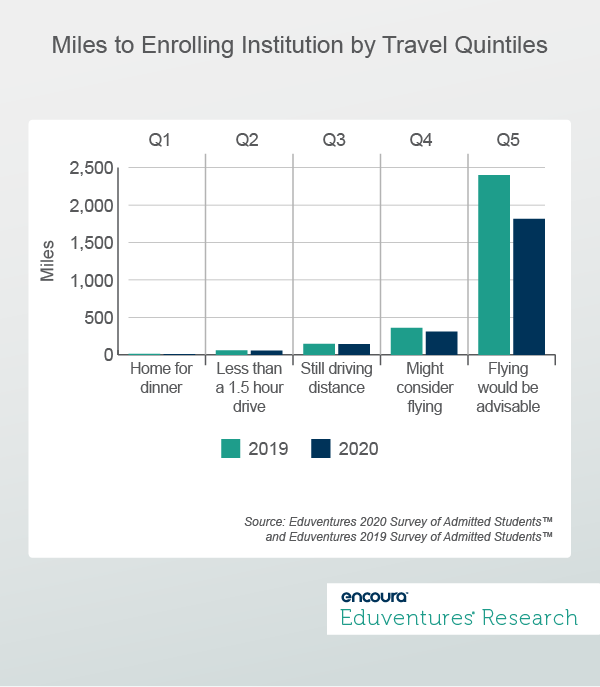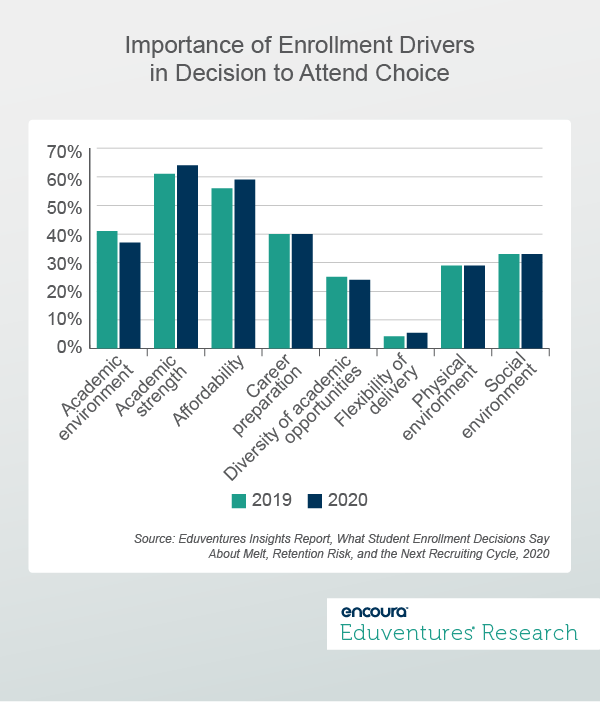While the unending chaos of COVID-19 makes it seem like everything is different in undergraduate college recruitment, in very important ways, everything is still the same. With more students choosing to stay closer to home, the crisis has created definite shifts in the enrollment market. But our research shows that students are even more clearly focused on the twin pillars of value in their enrollment choices: academic strength and affordability.
For institutions, this means it’s time to refocus on the essentials for recruiting and enrollment strategies: markets, competition, and message. Follow this eternal discipline and your institution will navigate the shifting terrain to a more certain enrollment outcome in very uncertain times.
Our comparison of the Eduventures Admitted Student Research from 2019 to 2020 reveals important differences in student enrollment choice behaviors between a normal enrollment year and this COVID-19 enrollment year. This data provides a guide for your institution to adjust and refine your recruiting strategy.
It is important to remember that a shift toward using remote tools and methods for recruiting doesn’t mean a shift away from essential messaging. According to our research, here are
Evaluate Your Markets
In particular, consider the geographic footprint of your markets. The COVID-19 crisis has had a strong effect on the distance many students are willing to travel for their education. The sudden angst of shutting down the 2019-2020 academic year is not long forgotten. The travails of making quick (and expensive) arrangements to return home from campus may have left an indelible mark. We are seeing evidence in the comparative data of a “homing” instinct, or a desire to be closer to home in case anything happens.
When we break students into five equally-sized “willingness to travel” groups and then examine the average number of miles each of these groups are willing to travel to their enrolling institution, we see that all students are less willing to travel. But COVID-19 has especially clipped the wings of the students who typically fly to reach their campus of choice (Figure 1).

The implication this has for recruiting is that students are of a more regional mindset; the five- or six-hour flight is daunting. A short-hop flight is better. Driving distance is especially comforting in a pandemic. Institutions that rely on significant out-of-state recruiting will have to revise their plans to reflect this regional mood.
Reassess Your Competition
Consider this: nationally, in our Admitted Student Research, we’ve seen an 8% increase in students enrolling in in-state public institutions, a 6% decline in enrollment at out-of-state public institutions, and a 3% decline in enrollment at private institutions between 2019 and 2020. Couple these trends with the knowledge that the travelers are just not traveling as far and this means that your competitive set will change.
This also means that the head-to-head comparisons that students will make between schools on academic programs will change, and so will pricing comparisons. Your admissions team should be prepared to have different conversations with students about their options in this changed landscape.
Sharpen Your Message
Students have always been focused on value—that mercurial combination of benefit and price. This is true, now more than ever. The focus on value is sharper for students in 2020 with some of the “nice to haves” falling a bit more by the wayside in favor of the “need to haves.” Figure 2 shows how the importance of key enrollment drivers has shifted between 2019 and 2020.

The data shows a sharpening of the value proposition related to the essence of what students want most: academic strength at a good price. This is the time to focus on these essentials.
The Bottom Line: The More Things Change, the More Things Stay the Same
We could easily get lost in all the changes that COVID-19 is forcing recruiting to undergo, and many of the changes are very important. But this is a subject for another day. Let’s focus here on the immutable—the deep strategy that institutions must constantly revisit to refine enrollment. This underlies all enrollment strategy in good times and in difficult times.
Recruit more regionally, with some exceptions.
The COVID-19 crisis has clipped the wings of travelers. Students who were inclined to make a cross country flight to a new part of the world for their education just are not as willing to do so. When making and adjusting your recruiting plans, take this into consideration. You’re likely to see continued depression in numbers of students from long distance markets—with some specific exceptions.
Be aware that your competitive set will change.
Institutions will now be in competition with a greater number of public and regional institutions—institutions they would not normally consider to be competitive. Thus, when recruiting and positioning your programs for students, you must revisit where your programs fit within this expanded set of competitors.
Sharpen your value proposition by focusing on the essentials.
Students still want to see their pathway at your university, but in the end, they will focus on the two most important things about a college education: academic strength and affordability. COVID–19 has crystallized the focus on these two enrollment drivers. When you communicate with students virtually this fall and winter, be direct. Show them their pathway; also show them that all roads lead to an affordable high-quality education.
For more detailed analysis of the changing enrollment environment our new report, What Student Enrollment Decisions Say About Melt, Retention Risk, and the Next Recruiting Cycle.
Never Miss Your Wake-Up Call
Learn more about our team of expert research analysts here.
Eduventures Principal Analyst at ACT | NRCCUA
Contact
The annual CHLOE (Changing Landscape of Online Education) survey chronicles the evolution of online policies and practices in U.S. higher education, from the perspective of Chief Online Officers (COOs). The fifth CHLOE survey captures leadership reflections on the pandemic-induced emergency remote instruction in the spring: what happened, what worked, and implications for fall. The CHLOE 5 report is published amid a coronavirus spike that is persuading many colleges and universities to re-think their fall re-opening plans.
This webinar will distill lessons from the spring and, in conversation with a panel of online leaders, gauge early fall realities. Online infrastructure, experience and leadership played a pivotal role in enabling schools to see through the last academic year, but many leaders have been quick to draw a distinction between hastily assembled “remote instruction” and true online learning. As fall 2020 gets underway, and schools face a yet stiffer test, online leaders are stepping up once again. Robust, engaging, high quality remote learning, by whatever name and whether or not combined with a socially distanced campus, will define this one-of-a-kind semester.

